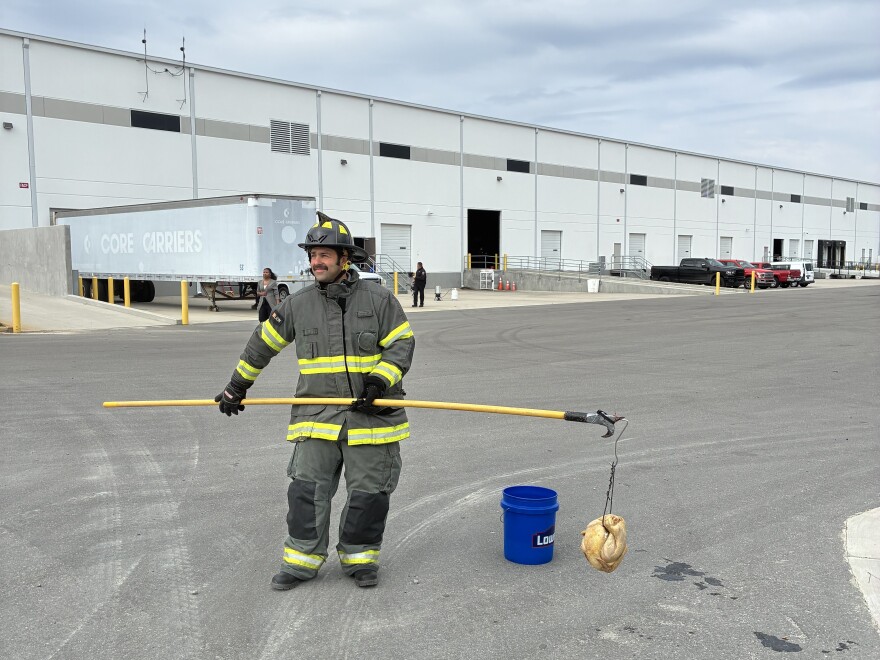It’s a southern tradition: a cajun-injected turkey fried in peanut oil. And firefighter Chris Blanchard has perfected his recipe: “I put it in a brine for 24 hours, the brine is brown sugar, kosher salt, garlic, worcestershire sauce.”
He’ll inject it with some cajun butter, then use a mix of cajun spices on the skin. “Coat it real good, put it back in the refrigerator while you’re waiting for your oil to heat up, then dunk it in, that’s it.”
It’s got to be fully thawed and patted dry for safety reasons: water and oil don’t mix. For a safety demo on the proper technique, the New Hanover County Fire Department had a pot set up outside. And when it came time to dunk the bird into the oil, Blanchard wore long sleeves and long pants with fire-safe gloves — the turkey on a long metal hook.
Britney Melvin, the community risk reduction coordinator for the fire department, said it's key to lower it in slowly. Having the oil at the right temperature is important too — 325 to 350 degrees.
"You do not want to necessarily go to anywhere that's combustible, so you don't want to go out into the woods or pine straw, things like that. You want to make sure that is a flat surface and that you're a safe distance away from your home," she said.
She set up this demo as a public safety announcement, hoping for a viral video. That’s why she also set up a risky version of turkey frying — with a fire truck at the ready.
Chemist Todd Doroski says a frozen turkey in hot oil can be explosive under the right conditions — especially if there’s some ice on the outside of the bird. If that’s dropped in oil, the ice rapidly turns into liquid water, and then steam.
"Water vapor is something like 1500 times bigger than liquid or ice. So when it is placed into that hot oil, it heats so rapidly that it just takes up a lot more space," he told WHQR.
And that oil can be dangerous once it gets exposed directly to fire, he said. "When the oil [bubbles over], you have usually a propane burner, and it comes out in such small droplets that sometimes it can burn, if the situation and circumstances are right.”
For this demo, the frozen turkey got the bomb treatment — dunked in oil from the end of a pole, with observers standing 40 feet away. It created a bit of a flare-up around the pot, and the oil spat everywhere. But no real explosion, to Melvin’s disappointment.
"New Hanover County Fire Rescue is so good at putting out fires that we can’t start one,” she said with a laugh.
The fire department tried as it might to get that turkey to blow. But the most it did was spit oil in a small radius, a few drops catching fire as they slid down the side of the pot.
Doroski said that’s probably a result of modern cooking equipment. "Those flames can be extremely well controlled. So even though you get some over splashing your flame may not be high enough to kind of start everything, reaction wise.”
For safety, it’s also worth measuring how much oil your turkey displaces. Melvin has a tip for that.
“You want to make sure that you measure your oil prior to actually warming it up. And you can do that by placing the turkey inside of the pot, putting water inside, and then taking the turkey out and seeing where that level is, and that's where you should place your oil," she said.
The demo wasn’t a total disappointment: Blanchard says at least his cajun turkey will find a safe home in the bellies of firefighters.
“It’s a covered dish thing today. So everybody kind of brought stuff, Thanksgiving-type foods, sweet potato pudding, rice and gravy, green bean casserole, bunch of different desserts," he said.
Maybe this demo was just a fun excuse for a department potluck. And even though the test turkey didn’t explode, Blanchard’s secret recipe smelled delicious.


